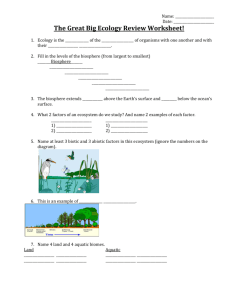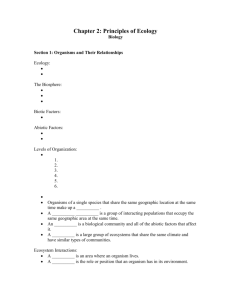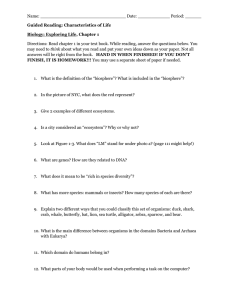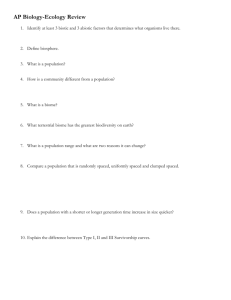Biology 20 Energy and Matter Exchange in the Biosphere
advertisement
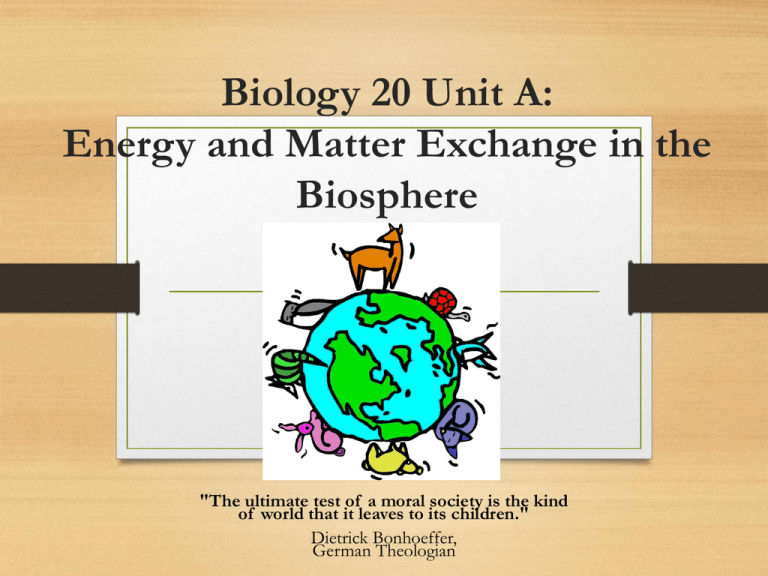
Biology 20 Unit A: Energy and Matter Exchange in the Biosphere "The ultimate test of a moral society is the kind of world that it leaves to its children." Dietrick Bonhoeffer, German Theologian Equilibrium in the Biosphere • According to the Gaia hypothesis, the earth is like a complex organism where many living (biotic) and nonliving (abiotic) systems interact. Like a living organism the earth is said to be in dynamic equilibrium where changes are continually occurring, but small adjustments are made to keep the whole system stable. Unfortunately, evidence suggests that humans are causing a disruption to the earth’s systems that can be detrimental to its, and our survival. The Biosphere • Refers to all areas of the earth in which living organisms are found. This includes: • Atmosphere – air • Lithosphere – land • Hydrosphere – water The Biosphere Biotic components – are the biological or living components of the biosphere, include all living things. • Ex. bacteria, fish, birds, mammals, plants Abiotic components – are the non-living components of the biosphere, include all chemical and physical factors. • Ex. Temperature, weather, soil acidity, sunlight In studying the health of the earth, scientists find it useful to study the biosphere at a variety of different levels. To determine the interactions between organisms and the environment, scientists may choose to study: • Populations – groups of organisms of a species living in a specific place at a specific time. Population studies allow scientists to study the interactions between the population and its environment. • Communities – all of the populations that live in a specific area at a specific time. Studying communities shows scientists how populations of different species affect one another. • Ecosystems – include communities and their abiotic environments. Studying ecosystems allows scientists to investigate the interactions between the living and non-living components or the earth. "When one tugs at a single thing in nature... he finds it attached to the rest of the world." John Muir Biodiversity – describes the biological diversity, number and variety of organisms, in an ecosystem. • More diverse food chains are more stable. All organisms in an ecosystem are either directly or indirectly affected by one another. If one species is removed from a limited food web, a domino effect occurs and the system will collapse. Equilibrium Unbalanced Dynamic Equilibrium – describes any system with constant change, where the components can adjust to the change without disturbing the entire system. • When the dynamic equilibrium becomes unbalanced for any reason, the healthy or numbers or organisms in that ecosystem are affected. Organisms can be classified according to their degree of risk Less severe risk Most severe risk Special concern – numbers are declining at the range / fringe of the area Threatened – species may become endangered if threatening conditions are not reversed Extirpated – a species no longer exists in one particular area, but is still found in other areas Endangered – a species is close to extinction in all parts of their natural habitat Extinct – a species no longer exists Indicator Species • are species of organisms that provide an early warning that an ecosystem is being affected by some factor. Usually, these species are very sensitive to changes in an ecosystem, or to specific changes of ecosystem conditions. Indicator species also play a specific role in an ecosystem and their decline will affect other organisms in the food web. Types of Indicator Species: • Producers – plants that convert sunlight • • • • energy into food Herbivores – animals that only feed on plants Carnivores – animals that only feed on other animals Omnivores – animals that eat both plants and other animals Decomposers – organisms that feed on detritus, dead and decaying biological material and return nutrients to the soil and water. Factors causing the disappearance of specific organisms include: • Loss of Habitat - clean, healthy habitats are often reduced or destroyed by human activity such as farming, industry and recreation. • Pollution – causes poor air and water quality which are detrimental to many organisms. • Climate Change – such as global warming causes the abiotic conditions such as temperature and humidity to change. Caused by pollutants. • Ultraviolet Radiation – increases the incidence of mutations and causes damage at the cellular level. Caused by damage to the ozone layer. Layers of the Atmosphere • Troposphere – up to 12 km, contains 80% of earth’s atmospheric mass (water vapour and dust). Weather systems occur here. • Stratosphere – up to 50 km above the troposphere, oxygen absorbs UV radiation forming ozone. • Mesosphere – up to 90 km above the stratosphere, cold temperatures, trace amounts of gas. Energy Conversions - Handout • Photosynthesis – is the process where producers capture solar energy and converted into food. CO2(g) + H2O(l) + sunlight C6H12O6(s) + O2(g) • Cellular Respiration – is the process where consumers break down glucose into carbon dioxide and water, releasing useable energy. C6H12O6(s) + O2(g) CO2(g) + H2O(l) + energy • The Albedo Effect – describes the extent to which light is reflected from the earth’s surface by clouds, snow or other highly reflective surfaces. • Handout Energy Transfer and Food Webs Living things can be categorized according to where they are in a hierarchy of energy. • Trophic Level – category that defines how living things gain energy for life processes. (feeding level) • Producers / Autotrophs – organisms that produce their own energy from either sunlight (photosynthesis) or chemical energy (chemosynthesis) Types of Organisms that exist: • Heterotrophs – organisms that feed on other organisms • Primary consumers – feed on autotrophs (herbivores) • Secondary consumers – feed on primary consumers (carnivores) • Top Carnivores – organisms that are not consumed by any other organism. • Chemosynthesis – the process where nonphotosynthetic organisms convert inorganic chemical compounds such as sulphur, iron, ammonia and hydrogen sulphide into energetic organic molecules. Bacteria capable of doing this are called chemoautotrophs. To Do: • Read Section 1.1 (Pages 8-14) • Page 15 Questions 1-8 • Species at risk worksheet (homework) Food Chains • single sequences illustrating a one way flow of energy in an ecosystem. Food Webs • are interlocking food chains that illustrate more complex feeding relationships between organisms. In all food chains, the amount of available energy decreases as you move up the chain. Valuable energy is lost in each and every energy conversion. So why is energy transfer so inefficient? 1. Most of the energy produced by autotrophs is used to promote the survival and growth of the organism. 2. Consumers don’t process all of the food they eat. Some is eliminated through waste. Much of the energy metabolized is also lost as heat. 3. Some of the energy taken in by a consumer is required to acquire, digest and metabolize the food eaten. 4. Energy transfer in biological systems always follows the first and second laws of thermodynamics: • First Law – energy cannot be created or destroyed, it can only be converted to other forms. • Second law – during any energy conversion, some of the energy is converted to heat, a form that is not recovered Scientific Models • Ecological Pyramids - can be used to represent the energy flow in food chains or food webs by showing the amount of energy, the number of organisms or the biomass. All pyramids illustrate the first / lowest trophic level on the bottom with successive trophic levels towards the top. Pyramids of Energy – illustrates the decreasing amount of energy available at each successive trophic level. Pyramids of Numbers – describe the number of organisms at each successive level of the food chain. These pyramids can often appear “inverted” when consumers are very small or producers are very large. Pyramids of Biomass – represents the dry mass of plant and animal tissues in a food chain. The amount of dry mass decreases at each trophic level. Here is a comparison of the three types of pyramids: To Do: • • • • Page 20 – Thought Lab 1.1 (Work in groups of 2-3) Biomagnification Activity Section 1.2 Review Quiz tomorrow on Chapter 1 (Second Half of Class) The Cycling of Matter in the Biosphere • The earth is a closed system, so although energy from the sun can come into the system and heat energy can leave, matter cannot. All of the molecules that make up everything on our planet stay here. Matter in the biosphere regularly changes form or cycles. Food molecules become cellular structures that become tissues and organisms. Eventually, those tissues and organisms become food for other organisms or decompose becoming part of the soil. The cycling of matter is a necessary part of all living things. Water • Water is required by all living things. It is important for a variety of reasons: • it absorbs and releases thermal energy • most metabolic reactions take place in water solutions • it is an excellent solvent due to its polar nature • it supplies hydrogen in photosynthetic reactions and oxygen during cellular respiration • it dissociates into acidic H+ and basic OH• it exists as a solid, liquid or a gas in earth’s atmosphere The Hydrologic Cycle • Transpiration – is the loss of water to the atmosphere through the leaves of plants. • Percolation – is the movement of water through porous soil. • Leaching – is the removal of soluble minerals by percolation. • Acid Deposition – is the precipitation of acidic solutions due to SOx and NOx gases combining with water (acid rain). The Universal Solvent • • • • Water is polar! What does that mean? Contains hydrogen bonds Do you remember adhesion and cohesion? Water stores heat… What can you tell me about its SHC? Homework • Section 2.1 Page 40 • Questions: • 2,4,5,6,7,8 Carbon • On earth, all organic substances are compounds of carbon, including those that make up living things. Carbon is also found in inorganic forms such as CO2 and carbonates. Combustion, decomposition and cellular respiration all produce inorganic carbon dioxide. Photosynthesis is required to capture inorganic carbon and convert it to organic carbon. These processes together are known as the carbon cycle. The Carbon Cycle Global Warming and the Greenhouse Effect Scientists believe that the average annual global temperatures are increasing. A number of theories exist that account for this phenomenon, however one of the more prevalent theories is the greenhouse effect. Greenhouse effect – is caused by increased amounts of atmospheric gases (CO2 and CH4) that prevent heat from escaping causing in increase in temperature on the earth’s surface. Nitrogen • Nitrogen is an important building block of proteins and nucleic acids. Proteins are required to build tissues and enzymatically mediate biochemical reactions. Nucleic acids (DNA, RNA and ATP) are components of key hereditary and metabolic compounds in all living things. Nitrogen gas is abundant on our planet and accounts for 79% of the atmosphere. To be useful to organisms, however, nitrogen must be in a more useable form like nitrate. The Nitrogen Cycle Nitrogen fixation is the process by which atmospheric nitrogen is converted to a useable form, nitrates. This is done by lightening and nitrogen fixing bacteria. Denitrification is the process where bacteria convert nitrates to nitrites, then to nitrogen gas which is released back into the atmosphere. Ammonification is the process where decomposers break down organic nitrogen containing compounds into simpler chemicals like ammonia. Bacteria in turn, change the ammonia into useable nitrates. • These conversions of nitrogen are all part of the nitrogen cycle. The Nitrogen Cycle Phosphorus • Phosphorus is required in cell membranes, ATP, DNA and in bone formation. Phosphorus cycles though the earth’s crust and through living organisms. The Phosphorus Cycle Fertilizers and Ecosystems Fertilizers – are materials used to restore nutrients to plants. Most fertilizers contain a ratio of Phosphorus, Nitrogen and Potassium (PNK) • The accumulation of phosphates and nitrogen caused by fertilizer use and spring runoff, allows algae to grow very rapidly in ponds and streams. When the algae die, bacteria use the available oxygen to decompose them. This results in less oxygen available for fish and other aquatic organisms. Group Project - Review • Each group will be assigned one of the cycles • Water • Carbon • Nitrogen • Phosphorus • Sulphur and Acid deposition • You must summarize and re-teach this concept to the class however you choose! Be creative • You must submit 5 test questions to me before you present – this might be used on the exam!
